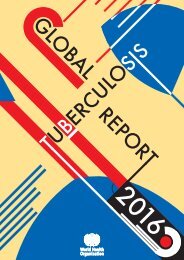patients
DNDi_AR_2015
DNDi_AR_2015
You also want an ePaper? Increase the reach of your titles
YUMPU automatically turns print PDFs into web optimized ePapers that Google loves.
HUMAN AFRICAN TRYPANOSOMIASIS / SLEEPING SICKNESS<br />
R&D MODEL & PORTFOLIO<br />
13.1 million people were estimated to live in areas at moderate<br />
to very high risk in 2012 (more than one case per 10,000 population)<br />
Disease is caused by two subspecies of Trypanosoma brucei (T. b.) gambiense (g-HAT; 98%<br />
of reported sleeping sickness cases) and T. b. rhodesiense (r-HAT), and occurs in two stages:<br />
the early stage has non-specific symptoms and is often un- or misdiagnosed, and the late<br />
stage, where the parasite crosses the blood-brain barrier, causing serious neurological<br />
disorders including sleep cycle disruptions, paralysis, and progressive mental deterioration.<br />
Without effective treatment, the disease usually leads to death. A lumbar puncture is needed<br />
to differentiate between stages in order to choose the appropriate treatment.<br />
Current treatments are difficult to administer, and stage-specific:<br />
TREATMENT OF STAGE 1 HAT<br />
Pentamidine (1940) for g-HAT and suramin (1920s) for r-HAT, require injections and are<br />
ineffective for stage 2.<br />
TREATMENT OF STAGE 2 HAT<br />
NECT – nifurtimox-eflornithine combination therapy (2009): for stage 2 g-HAT, requires<br />
14 slow intravenous infusions of eflornithine of 2 hours each over 7 days, together with<br />
three times a day oral nifurtimox for 10 days. Requires specialized hospital administration<br />
and trained staff. Since its addition to the EML, NECT is first-line treatment for stage 2<br />
g-HAT.<br />
Eflornithine (1981): today seldom used alone, requires an extended stay in hospital during<br />
administration (56 intravenous infusions – four times per day, over 14 days).<br />
Melarsoprol (1949): No longer used for g-HAT. Remains the only drug available for stage<br />
2 r-HAT – a toxic arsenic derivative that causes pain and fatal encephalopathy in up to 5%<br />
of <strong>patients</strong> who receive it.<br />
Epidemic<br />
Endemic<br />
T. b. gambiense<br />
T. b. rhodesiense<br />
T. b.<br />
gambiense<br />
is endemic<br />
in<br />
24 countries<br />
of West and Central Africa<br />
• Less than 3,000<br />
new cases reported (2015)<br />
T. b.<br />
rhodesiense<br />
is endemic<br />
in<br />
13 countries<br />
of Eastern and Southern<br />
Africa • 117 cases (2014)<br />
WHAT IS DNDi DOING TO ADDRESS UNMET TREATMENT NEEDS?<br />
At its inception, DNDi’s short-term<br />
strategy was to make better use of<br />
existing treatments by combining drugs<br />
already in use. In September 2009, DNDi<br />
and partners launched the first new<br />
treatment option for sleeping sickness<br />
in 25 years: nifurtimox and eflornithine<br />
combination therapy (NECT). NECT is<br />
included on the WHO Essential Medicines<br />
Lists (EML) for adults (since 2009) and<br />
children (since 2013), and virtually all<br />
T. b. gambiense endemic countries are<br />
now using NECT as first-line treatment<br />
for stage 2 g-HAT.<br />
As a medium-term strategy, DNDi<br />
initiated a compound mining effort to<br />
identify existing chemical compounds with<br />
potential against kinetoplastid diseases,<br />
resulting in the rediscovery of fexinidazole.<br />
After a complete Phase I programme,<br />
DNDi engaged in g-HAT patient studies.<br />
Inclusion into a pivotal Phase II/III study in<br />
stage 2 g-HAT is complete and patient<br />
follow-up is ongoing. Two complementary<br />
studies will examine efficacy and safety in<br />
adults with stage 1 and early stage<br />
2 g-HAT, in children aged 6-14 years, and<br />
a third one is being planned for r-HAT<br />
<strong>patients</strong>. Additional information will<br />
be obtained from a study in special<br />
population groups and to provide<br />
preliminary evidence on treatment<br />
compliance and effectiveness in<br />
ambulatory <strong>patients</strong>. Sanofi is the<br />
industrial partner.<br />
In order to build a strong pipeline for<br />
long-term drug discovery, DNDi<br />
established a HAT Lead Optimization<br />
Consortium resulting in identification of<br />
the oxaborole SCYX-7158, which<br />
successfully progressed through<br />
pre-clinical development. Phase I clinical<br />
development was completed in 2015 and<br />
preparations are underway for a<br />
prospective Phase II/III efficacy study in<br />
<strong>patients</strong>, to be initiated in 2016. Other<br />
backup compounds were evaluated by<br />
the consortium and remain available<br />
for further development if necessary.<br />
In addition, DNDi supports the HAT<br />
Platform (see p.59) that was launched in<br />
Kinshasa, Democratic Republic of the<br />
Congo (DRC) in 2005. The HAT Platform is<br />
a clinical research and access-supporting<br />
network for HAT endemic countries that<br />
brings together key players in the<br />
research on sleeping sickness in endemic<br />
countries and those involved in HAT from<br />
the international research arena, with<br />
partners having a role in developing HAT<br />
health policy participating in the Platform.<br />
Ideally a new treatment for adults and<br />
children would be effective against both<br />
stages of the disease and both parasite<br />
sub-species, non-toxic, have at least 95%<br />
efficacy at 18 months post end of dosing<br />
follow-up examination, be safe for<br />
pregnant and breastfeeding women, easy<br />
to use (short-course or once a day), oral,<br />
require no monitoring, affordable, and<br />
adapted to tropical climates.<br />
By 2018, DNDi aims to deliver<br />
from its HAT-specific portfolio:<br />
An oral, safe, effective<br />
treatment to be used for both<br />
stage 2 and stage 1 HAT.<br />
DNDi Annual Report 2015 › 23



